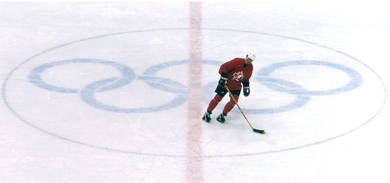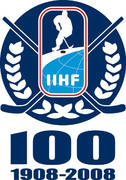Story #27
May 12, 1997 - May 31, 1998 - Helsinki, Finland - Lausanne, Switzerland
There is no doubt that taking away the red-line for the purpose of allowing the two-line pass was probably the most important rule change in hockey's modern era. But it was also the rule change that was the most difficult to pass during Congress meetings. When it finally happened, few delegates realized the ramifications of the rule change they had just passed.
The discussions to allow the two-line pass had started in the late 1980s and intensified in the early '90s when many teams - inspired by the Swedish mid-zone trap - started to employ this defensive tactic that clogged the neutral zone and made it all but impossible to penetrate the offensive end. As a result of this improvement to defence, many games became increasingly boring. Hockey became a victim of what soccer experienced in the mid-1960s. This was called the "catenaccio" system, a highly organized and effective backline defense which almost killed the game before offensive and creative forces took over and saved it.
The proposal to do away with the red-line and to allow the two-line pass finally came up as an agenda item during the 1997 IIHF Annual Congress in Helsinki, Finland. In his third year as IIHF President, René Fasel left his usual chairman's seat at the podium during the proceedings and walked back and forth on the congress floor while talking in the microphone to try to convince the voting delegates to accept this rule change.
Fasel won a half victory. The top hockey nations were asked to test the new rules on an optional basis at major tournaments during the 1997-1998-season. If no objections were presented over the season, the new rule would be in place permanently as of the 1998-1999-season.
As the 1998 IIHF Annual Congress in Lausanne started, there was one problem. No country had tested the rule. Not a single tournament during the entire 1997-1998-season was used for that particular purpose which meant that no delegates could give a report on the proposed rule change. So when the issue came up on the agenda as item 13 in 1998, IIHF General Secretary Jan-Ake Edvinsson reminded the congress about the decision from Helsinki from the previous congress. He stated that not a single recommendation for an adjustment of the new rules had been received by the IIHF office. Of course not, since no one had bothered to test it.
Edvinsson, simply following the congress decision from 1997, stated consequently that the rule change adopted at the Annual Congress in Helsinki would now be in effect, starting with the 1998-1999-season for all international games. Case closed, decision taken. International hockey had, in less than 30 seconds, adopted the most revolutionary rule change since allowing body-checking in all three zones in 1969.
The delegates looked at each other in amazement, and many of them were not really prepared for the decision. It took some minutes for them to realize what had just been decided, but they realized it was irreversible.
In hindsight, this was one of the most important congress decisions ever taken. Just a couple of weeks earlier Sweden and Finland had played a best-of-two World Championship final that amounted to a 120-minute snooze-fest. One goal was scored in the two games, by a defenseman from the blue line.
The new rule almost immediately changed the game for the better. The 1999 IIHF World Championship in Norway was a stark contrast to the finals the year before with many more goals scored and with end-to-end action – not defence – dominating play.
Today, no one can imagine going back. The fans and the creative players are the major beneficiaries. There are few plays in hockey that are more exciting than the beautiful outlet pass from a defenseman to a streaking winger who receives the 30 or 40 metre pass and cuts to the net. A decision that took less than a minute has turned into an everlasting story of success.
As part of the IIHF's 100th anniversary celebrations, www.IIHF.com is featuring the 100 top international hockey stories from the past century (1908-2008). Starting now and continuing through the 2008 IIHF World Championships in Canada, we will bring you approximately three stories a week counting down from Number 100 to Number 11.
The Final Top 10 Countdown will be one of the highlights of the IIHF's Centennial Gala Evening in Quebec City on May 17, the day prior to the Gold Medal Game of the 2008 World Championship.
These are the criteria for inclusion on this list: First, the story has to have had a considerable influence on international hockey. Second, it has to have had either a major immediate impact or a long-lasting significance on the game. Third, although it doesn't necessarily have to be about top players, the story does have to pertain to the highest level of play, notably Olympics, World Championships, and the like. The story can be about a single moment — a goal, a great save, a referee's call — or about an historic event of longer duration — a game, series, tournament, or rule change.
|










